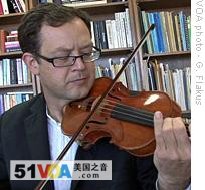College Station, Texas
09 March 2009
 |
| Joseph Nagyvary |
Retired Texas A & M University chemistry professor Joseph Nagyvary wanted to play the violin as a child, but World War II and the communist takeover of his native Hungary dashed that dream. After he left Hungary, he studied chemistry and also learned how to make his own violins.
Examining violins across northern Italy in the 1960s, he found that only instruments like the famed Stradivaris from Cremona and some others made in Venice had escaped damage from wood-eating worms.
"My conclusion was that in these two cities someone treated the wood with preservatives," he said.
Nagyvary began testing various preservatives to see if they affected the sound of violins he makes at a workshop behind his home in Texas. His breakthrough came from collaboration with colleagues in the Geology Department at Texas A & M University.
Professor Ray Guillemette utilized high technology, in the form of a microprobe machine that tests the chemical make-up of a substance.
"There are times when the machine is not in use, evenings or on weekends, and I got permission from my department to use several hours of microprobe time to solve this very interesting problem," Guillemette said.
He used tiny fragments of wood removed from Stradivari violins when they were being repaired, burned them in a laboratory oven and then tested the ash with the microprobe, which revealed the presence of such chemicals as sulfur, chlorine and boron.
"These are not present in any natural woods and they show up as very distinct from the natural woods," he said.
 |
| A Stradivarius violin |
While many musicians welcomed his research, Nagyvary says collectors and dealers in antique instruments were not pleased.
"It is easier to sell a Stradivari violin for $5 million when you say it is a product of some sort of mysterious divine inspiration," Nagyvary said.
While his research has been praised internationally, he says the music world is not so enthused.
"I could say that, with one or two exceptions, almost the entire industry was very negative, very antagonistic to a scientist wanting to do this kind of research," he said.
 |
| Brian Lewis |
"It has got a nice sound, I like it," he said.
But Lewis cannot say this new "Texas" violin is as good as a Stradivarius, because an instrument needs to be played for many years to develop its full potential.
"It would be a really great thing to compare what one of his violins sounds like after 30,000 hours of playing, because all of those Strads have been, quote-unquote, 'played in," Lewis said.
Violins made by Joseph Nagyvary and others using his technique may one day achieve the tonal excellence of the Stradivarius, showing that great music can come from chemistry.